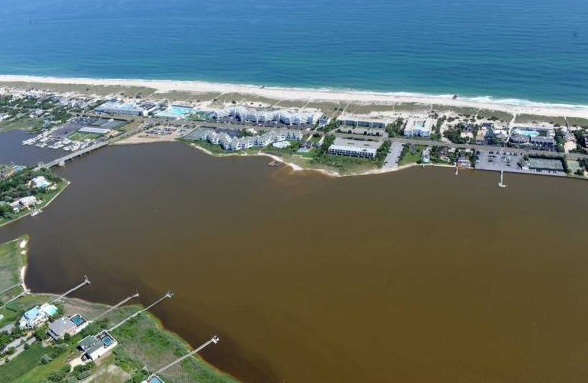The genetic flexibility of Aureococcus anophagefferens, the harmful alga responsible for "brown tides" off Long Island, allows it to thrive in conditions other algae cannot tolerate.
NCCOS-sponsored scientists assessed this alga's response to environmental stressors, such as low nutrients and low light, by looking at pieces of its RNA, which tell Aureococcus which proteins to make to exploit its environment. Under unfavorable conditions, gene expression increased for nitrogen use, arsenic detoxification, and metabolism of less-used organic compounds (e.g., urea), revealing the genetic flexibility underpinning physiological shifts that contribute to the ecological success of this species.

A brown tide clouds Moriches Bay. NCCOS-funded research shows that brown tides are capable of adapting quickly to changing environmental conditions, forming blooms sometimes toxic to shellfish and attenuating light that destroys seagrass beds. Credit: Stony Brook University.
Unlike most algae, A. anophagefferens can switch on genes that allow it to live for days in the dark. When other algae run out of preferred inorganic nutrients and die, A. anophagefferens can switch to organic nutrients, like those found in some lawn fertilizers and sewage. The research team fromWoods Hole Oceanographic Institution and Stony Brook Universitydetermined thatA. anophagefferens uses gene expression to quickly adjust to new conditions and maintain growth and reproduction.
The new research is improving the coastal management community's understanding of brown tides, which have decimated eastern Long Island's shellfishing industry. The team's results are published in the scientific journal Frontiers in Microbiology .
For more information, contact Quay.Dortch@noaa.gov.
 Official websites use .gov
A .gov website belongs to an official government organization in the United States.
Official websites use .gov
A .gov website belongs to an official government organization in the United States. Secure .gov websites use HTTPS
A lock or https:// means you’ve safely connected to the .gov website. Share sensitive information only on official, secure websites.
Secure .gov websites use HTTPS
A lock or https:// means you’ve safely connected to the .gov website. Share sensitive information only on official, secure websites.